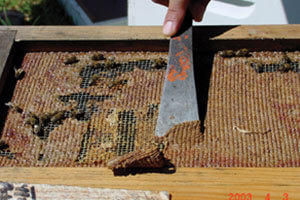
In my third installment in a mini-series on social immunity I want to give a summary of what this knowledge can teach us about practical honey bee health management. It’s useful to remind ourselves that agriculture, by definition, is the management of food plants and animals to achieve unnaturally high productivity. For example, a typical Holstein cow produces 9 gallons of milk per day1, whereas her 90-lb calf requires only 4.5 quarts per day2, an amount equal to only 12.5% of her mother’s daily production. This 87.5% excess over biological requirements is a good example of what agriculture does. And the same thing happens in beekeeping. A typical wild bee colony in autumn, after spending a summer converting incoming nectar into beeswax comb and workers, will end up with the balance of its nectar dehydrated down to about 44 pounds of honey, constituting its winter stores.3 If we think of this as analogous to the colony’s “surplus” honey, we may compare this value to colony yields for a commercial beekeeper which often range 2-5 times as high. I state this up-front to reinforce the fact that our standards for productivity are inflated by our agricultural inputs which include swarm control, stimulative feeding, larger-than-natural nest cavities, selective breeding, and short-term disease and parasite relief with antibiotics and acaricides. Being open to lessons from evolution and epidemiology requires of us the ability to critique the reigning paradigm.
Drawing upon my last two installments, I will focus on the five levels of increasing engagement that an organism, or superorganism, uses to avoid or contain pathogens or parasites4: (1) preventing parasite uptake, (2) preventing parasite intake, (3) preventing parasite establishment, (4) preventing parasite spread between tissues (or colony members), and (5) preventing spread of parasite to offspring.
- Preventing uptake
This is the first and most passive level of resistance – avoiding colony member exposure to pathogens and parasites. This, I believe, is one of the main selection drivers for large inter-colony distances in nature, known to range from 304-4848 meters5, another equally plausible reason being the avoidance of inter-colony food competition.
Epidemiology is rife with evidence that high host density encourages parasite virulence. From the parasite’s perspective, success is all about reproduction, and by definition a parasite is an organism that reproduces at the expense of its host. If it were a benign relationship we would call it commensalism, and if it were mutually dependent we would call it symbiosis. So it’s no surprise that a parasite’s reproductive success is usually positively associated with its virulence – the more reproductively successful the parasite, the more damaging to its host. This is likely true with Varroa and Apis mellifera, although many factors contribute to mite virulence, and it’s not easy to draw an equivocal connection between mite reproductive rate and colony morbidity.6 What is clear is that Varroa numbers do increase in conditions of high colony density. My PhD student Brett Nolan replicated apiaries of two colonies each with three levels of inter-colony distance: 0 meters, 10 meters, or 100 meters. All colonies were rendered nearly mite-free with powdered sugar and acaricides, then one colony in each pair was inoculated with 300 Varroa mites. Four months later, apiary mite averages were significantly lower in the 100-meter apiaries.5 Obviously, it is not practical to advise beekeepers to separate their hives by 100 meters, but the principle still holds, and I encourage beekeepers to think about ways one can reduce colony densities in one’s operation.
A second passive defense measure is the bees’ natural propensity to restrict foraging to the oldest worker cohorts in the colony. Given that nest enemies are, by definition, outside the nest, it is that portion of the nest population that leaves the nest that is in danger of making initial contact with infective agents, or “propagules.” If old individuals do pick up parasites, their relatively brief remaining lifetime limits their opportunity to spread the parasites to nestmates. This age bias normally happens on its own, but there are management situations where the beekeeper may disrupt this pattern. For example, if the beekeeper makes up splits in the middle of the day when old bees are out foraging, the splits may end up with unnaturally high ratios of young bees. When a colony loses its old bees, young bees are able to precociously jump ahead to foraging behaviors.7 Because these precocious foragers have a lot of life left ahead of them, they have a higher than average likelihood of encountering parasites and living long enough to transfer them to nestmates. One way to reduce this risk is to restrict split making to the early evening hours so that the resulting splits end up with more natural age distributions.
- Preventing intake
The most practical way to restrict parasite intake is to restrict nest entrance size. There is some compromise at work here because a …


